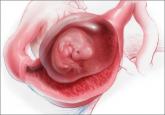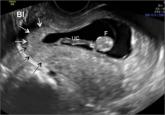For me, progesterone levels add one more piece to the puzzle. A patient with pain, vaginal bleeding, a quantitative hCG value of
500 mIU/mL, and a serum progesterone level of 20 ng/dL will have a normal pregnancy and is not a candidate for any intervention besides a follow-up hCG measurement to ascertain “doubling” of the analyte as expected in a normal pregnancy.
An asymptomatic patient whose quantitative hCG measurement is 1,000 mIU/mL and progesterone level is 4 ng/dL is carrying an abnormal pregnancy. If this quantitative hCG does not double appropriately in the follow-up, I counsel the patient about the greater chance of a spontaneous abortion or ectopic pregnancy.
Is this approach faulty?
Tomas Hernandez, MD
Pasco, Washington
I found Dr. Barbieri’s editorial very timely. It brings some clarity to the use of the hCG discriminatory zone in symptomatic pregnant patients.
An additional important point is that it is the clinician’s obligation to know the sensitivity of the test the laboratory uses. Serum tests use the threshold for a negative result of either less than 1 mIU/mL or less than 5 mIU/mL. If possible, serial hCG measurements should be performed in the same laboratory, because the result may not represent a true change in the hCG concentration if the second test is performed at a different laboratory.1 This is especially important when the clinician is considering the use of methotrexate to treat a suspected ectopic pregnancy.
Magdalen E. Hull, MD, MPH
Great River, New York
Reference
1. Meriko Mori K, Lurain, JR. Human chorionic gonadotropin: testing in pregnancy and gestational trophoblastic disease and causes of low persistent levels. UpToDate. http://www.uptodate.com/contents/human-chorionic-gonadotropin-testing-in-pregnancy-and-gesta tional-trophoblastic-disease-and-causes-of-low-persistent-levels. Published October 23, 2013. Accessed January 29, 2015.
I want to thank Dr. Barbieri for his important, timely message about suspected nonviable pregnancy. I agree with virtually all of his excellent suggestions. In fact, I was part of the consensus panel that developed the findings diagnostic of and suggestive of IUP failure.1 There are a few points, however, that I believe the readership of OBG Management should know.
The endothelial heart tube, the first organ system to form, folds in on itself and begins to beat at 21 days postconception. Thus, it is present and beating prior to our ability to image it on transvaginal ultrasound. Yet new guidelines1 now say not to call an IUP failed until there is a crown-rump length of 7 mm or greater with no cardiac activity. In the past, many clinicians used 4 or 5 mm. In fact, one of the most recent studies utilizing an 8-mHz transducer found all cardiac activity was visualized by 3.1 mm embryonic size!2
So why has the number been increased to 7 mm? I’ve given this a lot of thought. Most clinical trials, from which guidelines were derived in the past, were well-designed, tightly controlled, and performed by better-trained clinicians, often with state-of-the-art equipment. In contrast, well-meaning health-care providers practicing in the field are often without the same level of quality control, equipment, or expertise but are still expected to duplicate the data from the trials used to create the guidelines. The reason this is relevant pertains to the statement that 94% of 291 cases of ectopic pregnancy had an adnexal mass.3 This is an excellent study, done at one of the nation’s most outstanding academic institutions by world-class sonologists. I do not believe that well-meaning clinicians in the field will be able to achieve this level of detection.
Dr. Barbieri also discusses an inability to see an IUP even when hCG levels are greater than 1,500 or 2,000 mIU/mL or above. He mentions obesity, fibroids, and adenomyosis as increasing the risk of an ultrasound failing to detect an early IUP. This point needs to be expanded upon. Twenty-seven years ago, we claimed a discriminatory level of 1,025 mIU/mL of hCG if the gestational sac was normal and the uterus was normal with normal echo patterns. We had three cases with markedly greater hCG levels (one, in fact, as high as 5,544 mIU/mL)with coexisting fibroids.4
I would also submit that it is the axial uterus that is a very important source of potential error. The closer the beam of sound coming off of the footprint is to a right angle with the endometrium (as it will be in a markedly anteverted or retroverted uterus), the better the resulting image. With an axial uterus, the endometrium is in the same plane as the beam of sound, and this diminishes imaging capability. Furthermore, twin pregnancies are a potential confounder in attempting to correlate hCG levels in transvaginal ultrasound findings.



